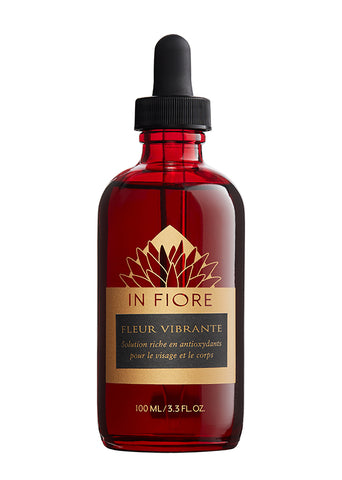Jasmine Sambac

Known as the flower of knowledge, Jasmine Sambac has a permeating warmth and purity and is known as the harmonizer or mother in our In Fiore blends. It’s also known as a mood enhancer and antidepressant remedy. Plus, its scent is beneficial in the restoration of energy, optimism, and confidence and is an essential antidote in the soothing of dry, irritated, or sensitive skin. Jasmine also restores moisture and radiance to dehydrated complexions.
Here, we reveal Jasmine Sambac’s constituents and attributes that lend to its healing prowess.
Botanical Source: Jasminum sambac (L.) Aiton, a member of the Oleaceae (olive) family, is an evergreen shrub or woody vine native to the humid Asian and Pacific subtropics. It has also adapted well to Mediterranean climates.
Alternate Names: Arabian jasmine, Pikake (Hawaiian), Sampaguita (Filipino), Melati putih (Indonesian), Mo li hua (Mandarin), Mali (Thai), Motia (Punjabi), Beli (Bengali), Moghra (Hindi, Marathi), Sumana, Yesmana (Arabic), and Xamelera (Catalan).
Constituents: Approximately 29-28% esters, 18% sesquiterpene a-farnesene, and monoterpenols.
Tropism: The aromatic essence of Jasmine Sambac resonates with the digestive and nervous systems. It has a particular affinity for the Heart, Pericardium, Liver, and Triple Heater meridians.
Preparation: The extraction process involves solvent extraction using food-grade hexane from freshly harvested flowers. The initial extraction yields the concrete, which is processed by washing with ethanol to produce the absolute extract.
Essential Function: Regulates Qi, calms the Heart, and soothes the Shen. Its cooling properties make it effective in addressing hypersthenic/hot terrain conditions, fevers, hot spells, skin inflammations, and dermatitis.
Traditional Use: Traditionally regarded as an aphrodisiac, Jasmine Sambac is used in combination with Jasmine Grandiflorum to address issues like poor circulation to the uterus, pelvic congestion, uterine spasm, contractions during menses, dysmenorrhea, low back pain during menses, and labor pains accompanied by discomfort during delivery.
Physiological: External applications such as massage to relieve muscle tension and promote relaxation. In general, Jasmine is considered to be a warming, relaxing restorative of the urogenital organs. It promotes tissue repair, relieves pain, strengthens the nerves, arrests catarrhal discharges and moistens the skin.
Psychological: Aromatic diffusion, whole body massage. PNEI (Psycho Neuro Endocrine Immunology) is euphoric in acute overstimulated conditions. Reduces deep limbic and cingulate system hyperfunctioning and resolves temporal lobe dysregulation. Promotes euphoria and resolves shock and trauma for short-term use in acute mental/emotional/physical conditions. Improves mental clarity, memory, focus, and concentration via inhalation.
Topical: Lotions, creams, balms, oils, and tonics, especially suitable for mature skin types, addressing wrinkles, scars, and inflammation. Its anti-inflammatory and astringent properties are beneficial. Jasmine Sambac is particularly effective for moisturization, rejuvenation, improving skin elasticity, reducing scars and stretch marks, and promoting a healthy complexion. It is contraindicated for babies, infants, young children, and internal use during pregnancy. Notably, it's employed for joint and muscle pain, spasms, dry and sensitive skin with redness and itching, oily skin, and dermatitis.
TCM: With a neutral to cool energy, Jasmine Sambac nourishes Heart and Liver Yin, regulates Qi, relaxes constraint, harmonizes the Heart, and balances the Shen. It addresses irritability, mood swings, restlessness, emotional behaviors, anxiety, nocturnal worries, fearfulness, insomnia, and palpitations.
Ayurveda: Known as "Mogra oil" or "Jasminum sambac oil," this essence has a history in Ayurveda for its therapeutic and aromatic attributes. It is believed to balance doshas, harmonize imbalances, and contribute to overall well-being. In Ayurvedic hair care, Jasmine Sambac oil strengthens hair follicles, prevents breakage, and imparts natural shine.
Chakra Affinity: Jasmine Sambac connects with the Base, Sacral, Heart, and Crown chakras.
Psychospiritual: The essence of Jasmine Sambac enhances spiritual experiences and facilitates a connection with higher consciousness.
Anthroposophical: Jasmine has intricate connections to the breasts, Shen, and feelings within the framework of anthroposophical understanding.
Jasmine is associated with breasts and sexual organs, suggesting a link with the spleen. In Chinese medicine, the spleen, related to the Earth element, is associated with fertility, pregnancy, birth, and nurturing. The breasts, also part of the Earth element, play a crucial role in nurturing and are linked to female sexuality and self-esteem.
Shen is one of the Three Treasures in Chinese medicine, along with chi and jing. Shen corresponds to the spirit, body and consciousness. Shen resides in two houses: the higher house for clarity of thought and the vital processes, and the lower residence (heart) for balanced feelings and communication.
Heart Shen is transformed by feeling and resides in the nerve-sense system. Anthroposophy connects the heart to spiritual understanding (Binah in Kabbalah). The breasts' proximity to the heart and Binah indicates a spiritual nourishment parallel to physical nourishment.
The rhythmic system harmonizes the nerve-sense and metabolic-limb systems. Balance between these systems is crucial for health. Feeling is positioned between thinking and willing, much like the rhythmic system's role.
Fleur Vibrante Solution
Fleur Vibrante + Adapt’Âscend bundle


